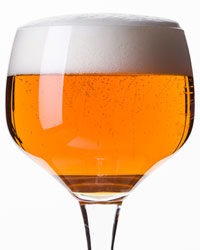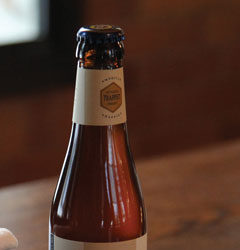Jamil’s Belgian Blond
Belgian Blond
(5 gallons/19 L, all-grain)
OG = 1.065 (15.8 °P) FG = 1.012 (3.0 °P)
IBU = 25 SRM = 5 ABV: = 7%
Ingredients
9.9 lb. (4.5 kg) Best Malz Pilsen (or similar continental Pilsner) malt (2 °L)
1.2 lbs. (560 g) cane or beet sugar (0 °L)
7 oz. (200 g) Franco-Belges aromatic malt (20 °L)
7 oz. (200 g) wheat malt (2 °L)
5.6 AAU Hallertau pellet hops (60 min.) (1.4 oz./39 g at 4% alpha acids)
White Labs WLP500 (Trappist Ale) or Wyeast 1214 (Belgian Ale) yeast
Step by Step
Belgian Pilsner malt is the natural choice for the base malt. Feel free to substitute any high quality malt of a similar flavor and color from a different supplier. The sugar I use is the cheapest table sugar I can find at my warehouse store.
Mill the grains and dough-in targeting a mash of around 1.5 quarts of water to 1 pound of grain (a liquor-to-grist ratio of about 3:1 by weight) and a temperature of 150 °F (66 °C). Hold the mash at 150 °F (66 °C) until enzymatic conversion is complete. Infuse the mash with near-boiling water while stirring or with a recirculating mash system raise the temperature to mash out at 168 °F (76 °C). Sparge slowly with 170 °F (77 °C) water, collecting wort until the pre-boil kettle volume is around 6.5 gallons (24.4 L) and the gravity is 1.050 (12.4 °P).
The total wort boil time is 90 minutes, which helps reduce the S-Methyl methionine (SMM) present in the lightly kilned Pilsner malt and results in less Dimethyl Sulfide (DMS) in the finished beer. Add the bittering hops with 60 minutes remaining in the boil. Add the sugar with 15 minutes left in the boil. Chill the wort rapidly to 64 °F (18 °C), let the break material settle, rack to the fermenter, pitch the yeast and aerate thoroughly.
You will need 2 packages of liquid yeast or you can make a 2.5L starter from 1 package. Pitch yeast at 64 °F (18 °C), aerate or oxygenate, and let the temperature rise slowly to 68 °F (20 °C) over the course of several days. Ferment until the yeast drops clear. With healthy yeast, fermentation should be complete in a week, but do not rush it. It is important for the beer to attenuate fully. Rack to a keg and force carbonate or rack to a bottling bucket, add priming sugar, and bottle. When finished, carbonate the beer to approximately 3 volumes.
Belgian Blond
(5 gallons/19 L, extract with grains)
OG = 1.065 (15.8 °P) FG = 1.012 (3.0 °P)
IBU = 25 SRM = 5 ABV = 7%
Ingredients
6.6 lb. (3 kg) Pilsner liquid malt extract (LME) (2 °L)
1 lb. (0.45 kg) light dried malt extract
1.1 lb. (500 g) cane or beet sugar (0 °L)
7 oz. (200 g) Franco-Belges aromatic malt (20 °L)
5.6 AAU Hallertau pellet hops (1.4 oz./39 g at 4% alpha acids) (60 min.)
White Labs WLP500 (Trappist Ale) or Wyeast 1214 (Belgian Ale) yeast
Step by Step
Try to find a Pilsner-type liquid malt extract made from 100% Pilsner malt, but feel free to substitute any high quality malt extract of a similar flavor and color. If you cannot get fresh liquid malt extract, it is better to use an appropriate amount of dry malt extract (DME) instead, since it does not oxidize nearly as fast and tends to be fresher. The sugar I use is the cheapest table sugar I can find at my warehouse store.
Because it can be tricky to get aromatic malt to convert by itself, you can consider the aromatic malt optional. You can omit it completely or replace it with a few ounces of Munich malt extract. If you do use the aromatic malt, it is best to try and get it to convert in a very simple mini mash. Mill or coarsely crack the aromatic malt and add it to 16 oz (0.5 L) of 158 °F (70 °C) water. Mix the grains until completely moist, and then do your best to keep the temperature between 150 and 160 °F (66 and 71 °C) for 30 minutes to one hour. You can do this by setting the container in a larger pot of hot water or wrapping it in a heating pad set on high. The warmer the temperature, the less time it will take to convert the starches, but don’t let it go higher than 160 °F (71 °C) to avoid accidentally denaturing the enzymes in the malt. When done the liquid will taste slightly sweet. If it doesn’t taste sweet, it didn’t convert. Strain out the grains and rinse with warm water. Add the liquid from the mini mash along with enough water and malt extract to make a pre-boil volume of 5.9 gallons (22.3 L) and a gravity of 1.055 (13.6 °P). Stir thoroughly to help dissolve the extract and bring to a boil. Once the wort is boiling, add the bittering hops. The total wort boil time is 1 hour after adding the bittering hops. Add the sugar with 15 minutes left in the boil. Chill the wort rapidly to 64 °F (18 °C), let the break material settle, rack to the fermenter, pitch the yeast and aerate thoroughly.
You will need 2 packages of liquid yeast or you can make a 2.5L starter from 1 package. Pitch yeast at 64 °F (18 °C), aerate or oxygenate, and let the temperature rise slowly to 68 °F (20 °C) over the course of several days. Ferment until the yeast drops clear. With healthy yeast, fermentation should be complete in a week, but do not rush it. It is important for the beer to attenuate fully. Rack to a keg and force carbonate or rack to a bottling bucket, add priming sugar, and bottle. When finished, carbonate the beer to approximately 3 volumes.
Written by Jamil Zainasheff
Jamil Zainasheff provides readers with a recipe to brew up an authentic Belgian-styled blonde ale.



